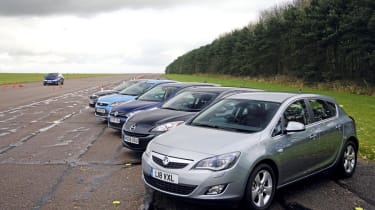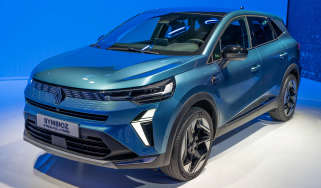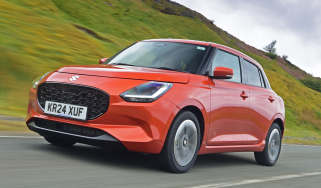Dynamics
Slalom tests and our tight handling track push our contenders’ agility to the limit
Any family hatch worth its salt has to stop, steer and handle safely – but a great one should be able to do all of that and offer some driver engagement as well. To find the dynamic master here, we devised three tough tests.
First of all, we put our family cars through an emergency lane change, while stopping from 60mph. This is an extreme test that replicates an evasive motorway manoeuvre and demonstrates braking performance. It also helps to gauge a vehicle’s stability control system, grip levels and steering responses.
Our second test was a 40mph slalom, designed to assess the body control, steering and agility of each model. And then finally, our contenders completed a lap of a twisty 500-metre kart circuit, to showcase their low-speed traction and the level of feedback.
Our test took place in damp conditions, and while the slippery tarmac at our track wasn’t perfect, it was still very effective in highlighting some key differences between the cars in our line-up.
The Golf excelled from the start. Through the slalom, it gave an impressive balance between front and rear grip, while the stability control was well judged. It also stopped quickly and, aided by gearing perfectly suited to our tight track, recorded the fastest lap time. But it wasn’t faultless.
The sharp steering on the Honda and Vauxhall provided more positive initial turn-in than the VW, and the effort required to steer the Golf varied as cornering loads increased. However, it provided a decent amount of feel.
In contrast, the Astra was a mixed bag. The keen initial response to steering inputs in the Vauxhall is excellent, and it changes direction with confidence. Grip levels and body control are good, too.
But while the steering isolates mid-corner bumps effectively, its neutral feel means you get little sense of how much grip is available.
Plus, in the lane change the Vauxhall’s over-active ABS and ESP intervention seemed to lengthen stopping distances.
The Skoda also took a reasonably long time to come to a halt. And in the slalom, the big Octavia’s body rolled from side to side – reducing grip. Its performance around our track was compromised by excessive dive under braking, too, and it just didn’t feel as composed as the Volkswagen.
The 3 and the Civic are at the other end of the dynamic spectrum to the Octavia. Their firm suspension set-ups mean there was minimal weight transfer in the slalom and lane change, while sharp steering ensures they turn in as positively as the Astra.
Both have effective stability control systems, to help prevent tail slides during high-speed direction changes, although the Honda requires the most counter steering to make it successfully through the test.
And what of the model that set new dynamic standards when it burst on to the family car scene? Well, the Focus still scores highly, with superb, communicative steering and a great handling balance.
Decent body control mean it is fun to drive, and inspires confidence, but its younger rivals put in stronger performances in our extreme brake test, leaving the Ford ranked in third place.



